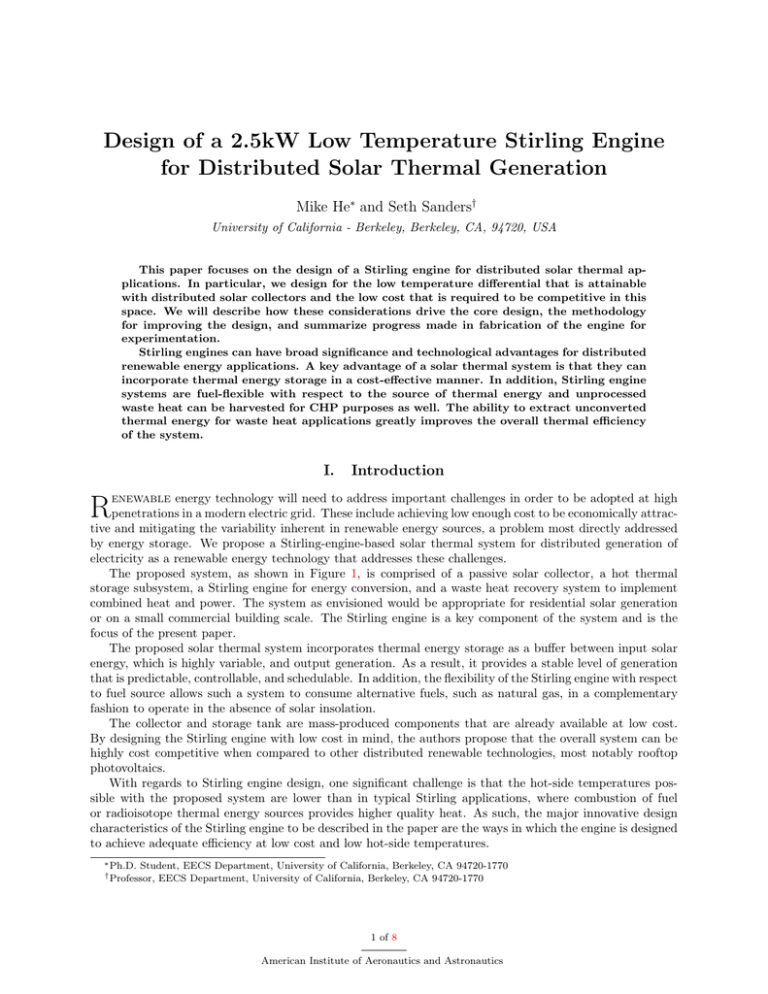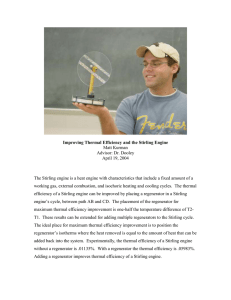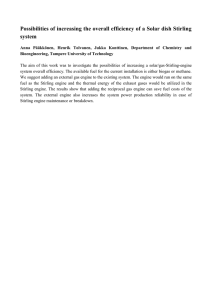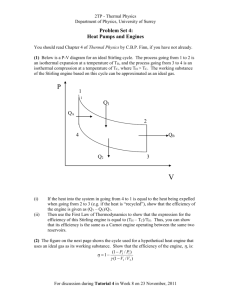Design of a 2.5kW Low Temperature Stirling Engine for Distributed
advertisement

Design of a 2.5kW Low Temperature Stirling Engine for Distributed Solar Thermal Generation Mike He∗ and Seth Sanders† University of California - Berkeley, Berkeley, CA, 94720, USA This paper focuses on the design of a Stirling engine for distributed solar thermal applications. In particular, we design for the low temperature differential that is attainable with distributed solar collectors and the low cost that is required to be competitive in this space. We will describe how these considerations drive the core design, the methodology for improving the design, and summarize progress made in fabrication of the engine for experimentation. Stirling engines can have broad significance and technological advantages for distributed renewable energy applications. A key advantage of a solar thermal system is that they can incorporate thermal energy storage in a cost-effective manner. In addition, Stirling engine systems are fuel-flexible with respect to the source of thermal energy and unprocessed waste heat can be harvested for CHP purposes as well. The ability to extract unconverted thermal energy for waste heat applications greatly improves the overall thermal efficiency of the system. I. Introduction enewable energy technology will need to address important challenges in order to be adopted at high R penetrations in a modern electric grid. These include achieving low enough cost to be economically attractive and mitigating the variability inherent in renewable energy sources, a problem most directly addressed by energy storage. We propose a Stirling-engine-based solar thermal system for distributed generation of electricity as a renewable energy technology that addresses these challenges. The proposed system, as shown in Figure 1, is comprised of a passive solar collector, a hot thermal storage subsystem, a Stirling engine for energy conversion, and a waste heat recovery system to implement combined heat and power. The system as envisioned would be appropriate for residential solar generation or on a small commercial building scale. The Stirling engine is a key component of the system and is the focus of the present paper. The proposed solar thermal system incorporates thermal energy storage as a buffer between input solar energy, which is highly variable, and output generation. As a result, it provides a stable level of generation that is predictable, controllable, and schedulable. In addition, the flexibility of the Stirling engine with respect to fuel source allows such a system to consume alternative fuels, such as natural gas, in a complementary fashion to operate in the absence of solar insolation. The collector and storage tank are mass-produced components that are already available at low cost. By designing the Stirling engine with low cost in mind, the authors propose that the overall system can be highly cost competitive when compared to other distributed renewable technologies, most notably rooftop photovoltaics. With regards to Stirling engine design, one significant challenge is that the hot-side temperatures possible with the proposed system are lower than in typical Stirling applications, where combustion of fuel or radioisotope thermal energy sources provides higher quality heat. As such, the major innovative design characteristics of the Stirling engine to be described in the paper are the ways in which the engine is designed to achieve adequate efficiency at low cost and low hot-side temperatures. ∗ Ph.D. Student, EECS Department, University of California, Berkeley, CA 94720-1770 EECS Department, University of California, Berkeley, CA 94720-1770 † Professor, 1 of 8 American Institute of Aeronautics and Astronautics Figure 1. Schematic of the proposed Stirling engine system. II. Motivation Stirling engines have found various applications as energy converters for highly-concentrated solar thermal plants, coolers and heat pumps, and other specialized applications such as space flight. This design differs from typical applications in that we design for lower temperature differentials and that low cost of materials and fabrication is a priority. In contrast, size and mass are of lower importance. This application area has been the focus of less research in the literature and warrants additional investigation. In particular, as renewable energy and energy efficiency have become more critical areas of research in recent years, the design and development of a Stirling engine system that can be commercialized for thermal energy generation applications and as a combined heat and power system would add significant value. III. A. Design Design Goals The core design goal is achieving high efficiency at low cost. In the space of energy applications, the low price of energy requires technologies to satisfy tight constraints on cost and produce enough energy to be competitive. Previous analytic and empirical results from the design and development of low-power engine prototypes in this space informed many of the design goals and decisions of this prototype.1, 2 In order to achieve adequate efficiency and performance at low temperature differentials, we first focused on designing high performance heat exchangers with the goal of minimizing all temperature drops along the path of thermal energy flow from input to output. By maximizing the temperature differential available to the Stirling cycle itself, higher performance can be achieved at low temperature differential. Simultaneously, the heat exchanger design had to be low cost, precluding high performance designs that require more complicated features. As a result, the design was chosen for simplicity of fabrication. B. Design Methodology The design process for the engine consisted of thermal analysis and adiabatic cycle simulations feeding into parameter optimizations, and tempered with evaluation of cost and fabrication simplicity. The first step of the design process was to create a proposed configuration and layout, then characterize the performance of the heat exchangers based on the designed geometry, using thermal physics and analytic and empirical fluid dynamics models from literature (e.g.3 ). This information was then used in an adiabatic cycle simulation to predict cycle performance, internal pressure waveforms, and cycle losses. This stage allowed us to characterize the predicted performance of 2 of 8 American Institute of Aeronautics and Astronautics the engine in terms of efficiency, output power, and complete a picture of losses. Finally, optimization procedures over different sets of parameters were performed to refine the results and maximize predicted performance. A wide range of options was considered for the overall engine geometric configuration, heat exchanger geometry, working fluid composition, and piston motion mechanics (free-piston vs kinematic). C. Heat Exchangers and Regenerator In order to achieve adequate efficiency and performance at low temperature differentials, the design of the heat exchanger components focused on reducing temperature drops as much as possible and reducing loss components, such as gas flow friction, conduction losses, and gas hysteresis losses. The design was chosen to also reduce the amount of machining required and to use low cost materials in order to reduce overall cost. The key tradeoff in achieving high efficiency is between the regenerator and heat exchanger effectiveness and the flow loss in these components. Ultimately the best performance is achieved by designing for small hydraulic diameters and wide cross-sectional areas.3, 4 The overall engine geometry was designed with high cross-sectional areas to the direction of working fluid flow in order to reduce flow friction losses while not compromising wetted area for heat transfer. The regenerator was chosen to be ultra-fine fiberglass mesh, compacted to achieve the desired porosity for heat transfer and flow loss properties. This material allows for small hydraulic diameter for improved heat transfer with very lost cost. The hot-side and cold-side heat exchangers are comprised of aluminum plates for heat transfer from an externally pumped hot or cold liquid, integrated with fine copper mesh weaves to transfer thermal energy to the internal working fluid. Expected temperature drops for the various heat exchanger components are listed in Table 1. Table 1. Expected temperature drops in heat exchanger components Component Hot-side Liquid to Metal Hot-side Metal to Air Cold-side Liquid to Metal Cold-side Metal to Air D. T emperatureDrop(C) 1.79 1.26 2.42 1.09 Adiabatic Model An adiabatic model of the Stirling cycle was used to calculate expected performance.5 The adiabatic model assumes that the net heat transferred over a cycle from the hot side to the cold side, plus work produced, is equal to the heat transferred by the heat exchangers. This analysis is more detailed than isothermal models of the Stirling cycle and, as a result, no closed-form solution exists, but rather requires numeric simulation. What is gained is greater accuracy of results.5 Internal pressure and temperature waveforms as predicted by the adiabatic model are plotted in Figure 2. The heat exchanger characterization forms an important input into this process, providing information on thermal flows and losses. The outputs of this step are performance metrics, such as efficiency and mechanical output power. The losses that are accounted for in this model include enthalpy losses from uncaptured heat in the regenerator, flow frictional losses through the engine, conduction losses, gas hysteresis losses, enthalpy losses from leakages, and other smaller losses.5, 6 A full diagram of energy flows and losses appears in Figure 5. E. Optimization This analysis was folded into an optimization routine that scanned over the parameter space and refined design parameters to improve design performance. This step was key in guiding the final design process. Key parameters that were explored include regenerator geometry, heat exchanger meshes, and displacer and power piston strokes. Example graphs used during the optimization process are displayed in Figure 3 and 4. An important conclusion drawn through this process is that the most significant design tradeoff is between increasing regenerator effectiveness by increasing the length of the regenerator stack, and the increased gas 3 of 8 American Institute of Aeronautics and Astronautics (a) Internal pressure waveform from adiabatic model. (b) Temperature waveforms from adiabatic model. Figure 2. Simulation results from the Adiabatic model of the Stirling cycle. (a) 30 bar Air, 20 Hz Freq (b) 30 bar Air, 30 Hz Freq (c) 30 bar He, 20 Hz Freq (d) 30 bar He, 30 Hz Freq Figure 3. Plots of example optimization graphs. These graphs show power output and efficiency contours plotted against piston strokes, plotted for different test cases of engine frequency and working fluid composition. 4 of 8 American Institute of Aeronautics and Astronautics (a) 30 bar Air, 20 Hz Freq (b) 30 bar Air, 30 Hz Freq (c) 30 bar He, 20 Hz Freq (d) 30 bar He, 30 Hz Freq Figure 4. Overall efficiency (top) and regenerator losses (bottom) as a function of regenerator length. 5 of 8 American Institute of Aeronautics and Astronautics flow friction that results. Other significant trade-offs include the analogous example of heat exchangers, increasing pressure versus frequency, and piston strokes. F. Selected Design The selected engine design for this application is at an operating point of 20Hz with 30 bar pressurized air as the working fluid. Operating at 20Hz provides good balance between output power and losses, and also allows the engine to interface with a 6-pole alternator to achieve an electrical frequency of 60Hz, allowing direct grid connection if desired. A gamma configuration is chosen as a natural geometric fit with the heat exchangers and to reduce sealing challenges. The rated power output of the engine was designed at 2.5 kW, a level appropriate for satisfying the majority of demands in small buildings, residential or commercial. A kinematic piston design was chosen to simplify the design with respect to the dynamics of the system and the fabrication process. Table 2. Design Parameters Design Quantity Nominal Power Output Thermal-Electric Efficiency Fraction of Carnot Efficiency Hot Side Temperature Cold Side Temperature Working Gas (Air) Pressure Engine Frequency Electrical Output Regenerator Effectiveness Piston Swept Volume Value 2.525 kW 21% 65% 180 °C 30 °C 25 bar 20 Hz 60Hz, 3φ 0.9967 2.2 L The heat exchangers were optimized for the tradeoff between heat transfer effectiveness and flow frictional losses. The objective is to provide a high conductivity, high cross-sectional area thermal path for input heat to flow. The large total open area presented to the gas flow is designed to lower flow resistance while providing for low temperature drops in the thermal path. The displacer piston was designed to be fabricated from two light aluminum plates and a hollow interior reinforced with standoffs in order to reduce mass and simplify fabrication. The power piston is a solid steel cylinder that was weighted to achieve resonance with the gas spring of the working fluid. Both pistons were designed with clearance seals to reduce cost and increase longevity. The swept volume of the power piston per stroke is 2.2L. The predicted performance of this engine at a rated output power of 2.5kW is approximately 21% thermal to mechanical conversion efficiency. This represents approximately 63% of the Carnot efficiency at these temperatures. The largest loss component is enthalpy loss from uncaptured heat in the regenerator, followed by flow frictional loss in the regenerator, then by flow losses in the heat exchangers. Important performance and design parameters are listed in Table 2. A figure of predicted energy flows in the engine, including thermal flows and losses, is given in Figure 5. IV. Fabrication and Experimental Setup The fabrication process of the Stirling engine design was relatively simple. The most complicated machined part, the heat exchangers, is simpler than typical high performance heat exchangers, consisting of a flat aluminum plate and requiring two milling steps. Other components that required machining include the crankshaft assembly, which was modeled after automotive crankshafts to simplify fabrication. To simplify sealing requirements, the crankcase was contained in the fully pressurized working environment. Off-theshelf bearings are used in the crankshaft assembly. Two large steel plates anchor the engine and provide structural support, but do not require significant machining. The copper mesh weaves are readily available as off-the-shelf product. The power piston was coated with a Teflon-based coating to reduce friction. 6 of 8 American Institute of Aeronautics and Astronautics Figure 5. Predicted energy flows in the engine. (a) CAD model. (b) Engine photograph. Figure 6. Selected components from fabricated engine. 7 of 8 American Institute of Aeronautics and Astronautics Pictures of some of the components in the fabricated prototype are shown in Figure 6. The next step is to perform experiments to empirically validate the design predictions. Important data to measure include cycle performance characteristics such as the internal pressure waveform, heat exchanger performance, loss components, and overall power output and efficiency. V. Conclusion Due to the relatively low hot-side temperatures as compared to traditional Stirling engine applications, high overall efficiency is harder to achieve and requires careful design in maximizing heat transfer capabilities of the heat exchangers in order to reduce temperature drops. Careful optimization of various loss components versus metrics such as output power is an important part of the design process. The Stirling engine system as described was designed with these considerations in mind. Furthermore, the engine must be designed at low cost to be competitive for energy applications. This requires component geometries and materials to be designed to simplify fabrication and utilize low-cost materials and mass-produced components. The overall engine geometry and components such as the regenerator, heat exchanger, and mechanical components were designed to meet these constraints. The Stirling engine as designed is expected to achieve relatively high performance as a fraction of the Carnot efficiency and have low-cost in fabrication in mass production. We will be conducting experimentation to verify the design performance in the near future. VI. Acknowledgments M. He thanks the National Science Foundation Graduate Research Fellowship and NSF Award 0932209, “LoCal - A Network Architecture for Localized Electrical Energy Reduction, Generation and Sharing”, for supporting this project. References 1 Minassians, A. D. and Sanders, S. R., “A Magnetically-Actuated Resonant-Displacer Free-Piston Stirling Machine,” 5th International Energy Conversion Engineering Conference and Exhibit (IECEC), June 25-27 2007. 2 Minassians, A. D. and Sanders, S. R., “Multi- Phase Stirling Engines,” 6th International Energy Conversion Engineering Conference and Exhibit (IECEC), July 28-30 2008. 3 Makoto, T., Iwao, Y., and Fumitake, C., “Flow and Heat Transfer Characteristics of the Stirling Engine Regenerator in an Oscillating Flow,” JSME international journal, Vol. 33, No. 2, 05-15 1990, pp. 283–289. 4 Incropera, F. P., Fundamentals of Heat and Mass Transfer , John Wiley & Sons, 2006. 5 Urieli, I. and Berchowitz, D., Stirling Cycle Engine Analysis, Adam Hilger, Bristol, UK, 1984. 6 Minassians, A. D., Stirling Engines for Low-Temperature Solar-Thermal-Electric Power Generation, Ph.D. thesis, University of California - Berkeley, 2007. 8 of 8 American Institute of Aeronautics and Astronautics


